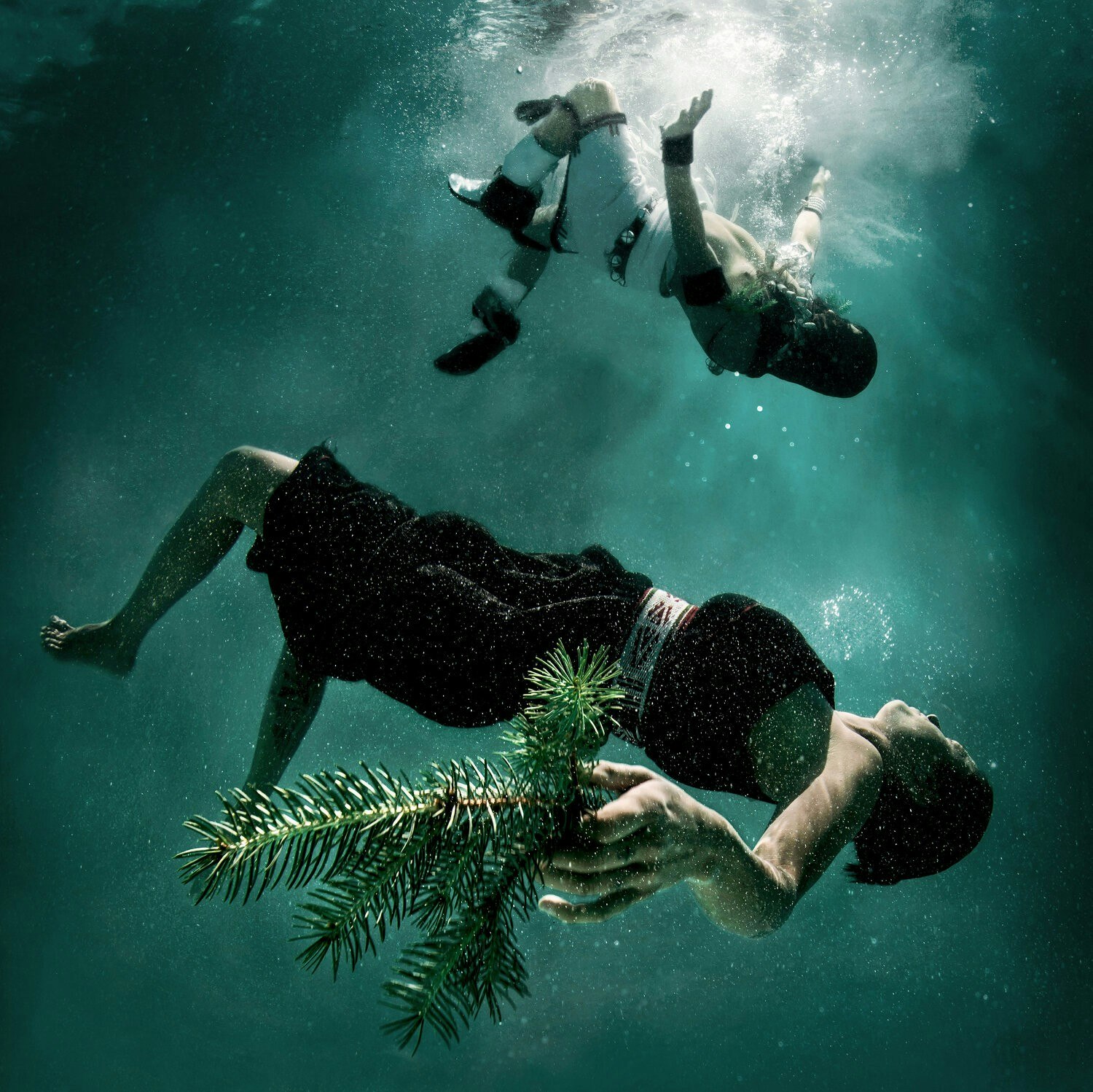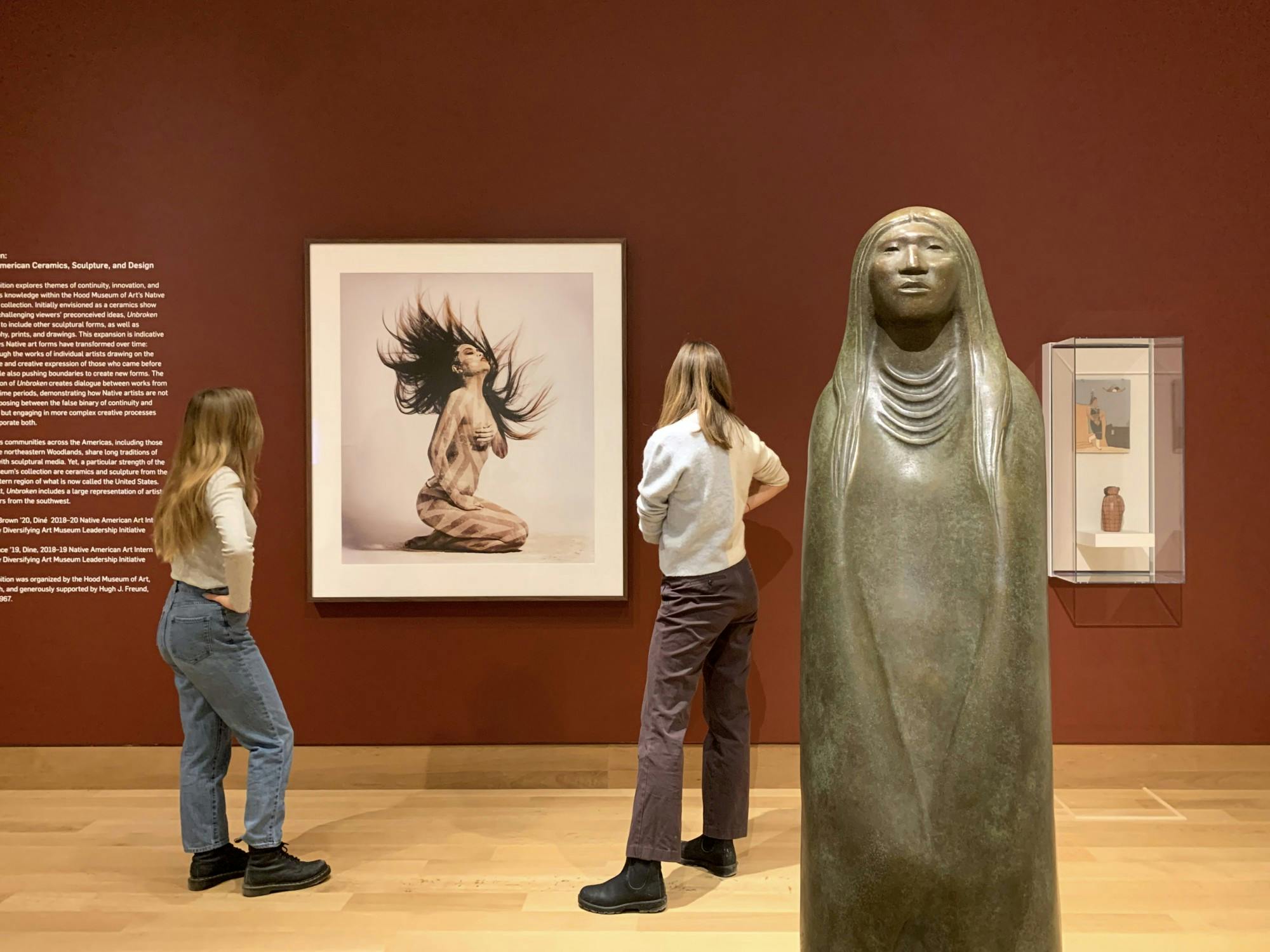On Feb. 9, the Hood Museum of Art will host a talk with Cara Romero, moderated by curator of Indigenous art Jami Powell. Three of Romero’s pieces — “Kaa,” “Oil Boom” and “Water Memory” — are currently on display in two exhibitions in the Hood: “Unbroken: Native American Ceramics, Sculpture and Design” and “This Land: American Engagement with the Natural World.”
Romero, a member of the Chemehuevi Indian Tribe who was raised on the Chemehuevi Reservation in California, is a contemporary photographer whose work over the years has reinterpreted stories of Native American identity and Native American women. Many of her photographs and fine art series have been collaborations with other Native American artists, whose portrayals in her photographs not only tell Romero’s story, but the stories of other Native American tribes and experiences.
“Kaa” — currently on display in Unbroken — is a photograph of Kaa Folwell, a Pueblo potter. Dillen Peace ’19, a former Hood intern who co-curated Unbroken, spoke about the importance of the collaboration between Romero and Folwell in the creation of the piece, which tells the story of clay in Native communities, and how it has been passed down as an art form for centuries.

Cara Romero (Chemehuevi), Kaa, 2017, archival pigment print on fine art matte paper. Hood Museum of Art, Dartmouth: Purchased through the Sondra and Charles Gilman, Jr. Foundation Fund; 2019.78.1. © Cara Romero
Peace explained that the direction of this work was shaped by the ideology behind the ceramic making, with a focus on the sacred nature of the art rather than the physical objects themselves. The importance of ceramic and pottery making is difficult to grasp from an outside perspective, highlighting the importance of this art as it provides insight for the average viewer.
“For most Indigenous people, [ceramic making is] very much a spiritual and cosmological understanding, and that’s what 'Kaa' kind of represented for their people: that there was a sacred aspect to what the ceramic and pottery-making meant to them,” said Peace.
Peace also noted the collaborative aspect of Romero’s process in creating “Oil Boom,” currently on display in This Land. Romero worked with Indigenous artist Cannupa Hanska Luger, who is of Mandan, Hidatsa, Arikara and Lakota descent, and is also the subject of the work. Luger’s presence makes the photograph more intimate and personal because the expansion of the drilling industry in Native American lands for oil, called the oil boom, has personally affected his community, according to Peace.

Cara Romero, Oil Boom, 2015, archival pigment print AP 1/3. Hood Museum of Art, Dartmouth: Purchased through the Sondra and Charles Gilman, Jr. Foundation Fund; 2019.78.2. © Cara Romero
Romero incorporates many experiences into her work by collaborating with a variety of people — such as the affiliated tribes from the Northern US — to employ their stories in her art to create a holistic view on what it means to be a Native today.
“She’s able to incorporate a lot of their experience and what their thoughts are about what the work should be and what the work is about…Because she was working with Cannupa Hanska Luger and he comes from the three affiliated tribes up north and they are having these conversations and issues that deal with the oil boom that has been happening, the work very much became about that just because it feeds on that image,” said Peace.
Powell first brought Romero’s pieces into the Hood in 2018. To Powell, Romero’s pieces are significant from both an academic and social perspective because they exist at the intersection of Native identity and environmental justice. Since then, the Hood has acquired five of Romero’s pieces and plans to host a solo exhibition of Romero’s work in 2025, according to Powell.
Powell noted the intellectual generosity demonstrated by artists as they bring their understanding and experiences into a public forum.
“Within her photographs, Cara is sometimes talking about really difficult issues,” said Powell. “For instance, in ‘Oil Boom,’ she’s talking about the violence of colonial displacement and natural resource extraction, but she is so generous in her invocation to the viewer to engage in this difficult conversation that it doesn’t make people feel that they’re being called out or make them feel bad.”
Sháńdíín Brown ’20, former Hood intern and the other co-curator of Unbroken, also talked about Romero’s use of photography to reinterpret the artistic expressions of Native peoples and tribes throughout history. In particular, Brown highlighted Romero’s series of billboards titled “TONGVALAND,” which addresses environmental justice and the Indigenous people who still live in Los Angeles , and her “First American Girl” portraits, which foreground the current stereotyping and caricaturization of Native women in popular media.
“For Cara as a Chemehuevi artist, I guess you could say photography is not a traditional art form of the tribe, but she is expanding on what is Native American art,” said Brown. “For a long time, it was just traditional practices, so I think it’s really powerful that she’s doing new things.”

Cara Romero, Water Memory, 2015, archival pigment print on Canson Legacy Platine Photo Paper. Hood Museum of Art, Dartmouth: Purchased with a gift from the Douglas Wise ’59 Memorial Arts Fund; 2020.38.1. © Cara Romero
Brown said that she hopes after the talk, audience members will expand their perspectives of Native artistic practices.
“Sometimes, Native American artists are doing ‘controversial’ work, or things that are out of this typical Western or American art history point of view, and just being open to those ideas is really powerful,” said Brown.
Peace agreed, pointing out that Romero’s practices are a continuation of Indigenous storytelling — an art form that has existed for centuries. He hopes that the audience will see that Native artists are continuing to participate in a dialogue about how to stay true to one’s tribe and history while adapting contemporary mediums.
“We’ve been telling our stories for the longest time, but most of them were not told in an intimate setting, whereas now we’re seeing that a lot of our stories are very relevant to changes that need to be made today, changes that we’re becoming more aware of,” Peace said.




